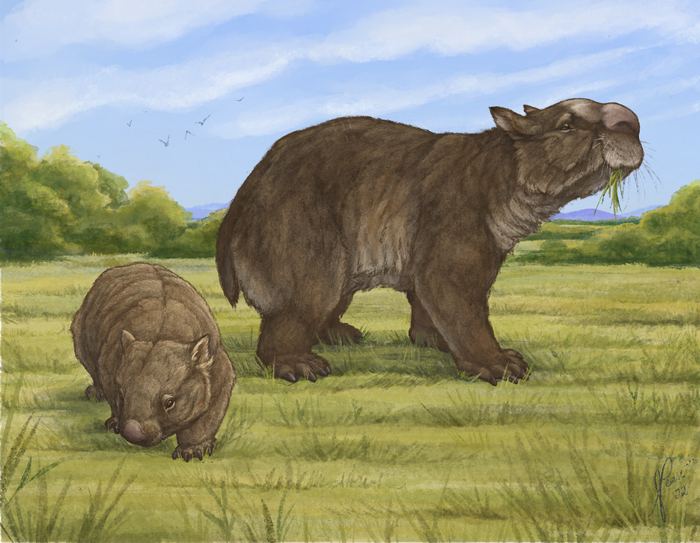If you thought Australia was home to only one ancient ‘giant wombat’, think again.

Credit: Eleanor Pease
If you thought Australia was home to only one ancient ‘giant wombat’, think again.
While the Diprotodon – the extinct megafauna species that is distantly related to wombats but was the size of a small car – is commonly (but incorrectly) thought of as Australia’s ‘giant wombat’, researchers from Griffith University have shed light on a large species that does belong in the modern-day wombat family.
The complete skull of this true fossil giant wombat, found in a Rockhampton cave in Queensland and estimated to be around 80,000 years old, has been described for the first time by a team led by Associate Professor Julien Louys from Griffith’s Australian Research Centre for Human Evolution.
Associate Professor Louys said the discovery provided unprecedented insights into the biology and appearance of these previously little known ‘gentle giants’.
“The extinct megafauna of Australia never ceases to amaze and intrigue not just Australians, but people all over the world,” he said.
“Although one of the most charismatic of the giant mammals to go extinct, Diprotodon is commonly referred to as a ‘giant wombat’. But this is incorrect as Diprotodon belongs to an entirely different family – equivalent to saying a hippo is just a giant pig.
“There were however, true giant wombats. These have traditionally been poorly known, but the discovery of the most complete skull of one of these giants, Ramsayia, has provided us with an opportunity to reconstruct what this creature looked like, where and when it lived, and how the evolution of giant wombats took place in Australia.”
The cranium and mandible of the Ramsayia magna fossil was discovered from the rear of the front chamber of Lower Johansons Cave in Rockhampton in the early 2000s, but it was only through subsequent excavations and analysis by Associate Professor Louys’s team that is was confirmed as belonging to a previously described but very poorly known species.
Extinct giant wombats of the family Vombatidae (broadly defined as twice the size of modern wombats) are rarer than the fossil diprotodontids that are often popularly – and incorrectly – referred to as giant wombats.
Associate Professor Louys said this giant wombat – Ramsayia – had extensive cranial sinuses, which had not been previously reported for a wombat.
“This indicates that the wombat had a large, rounded skull for the attachment of specific and strong chewing muscles,” he said.
“The giant wombat also possessed a ‘premaxillary spine’, an indication that it had a large, fleshy nose.
“In this paper, we show that all true giant wombats evolved large body sizes first, then individually became quite specialised to eat different types of grasses.
“We also dated this species as being about 80,000 years old. This is the first date for this species and is much earlier than human arrival in Australia, although we still don’t know exactly when or why this species became extinct.”
The research ‘Cranial remains of Ramsayia magna from the Late Pleistocene of Australia and the evolution of gigantism in wombats (Marsupialia, Vombatidae)’ has been published in Papers In Palaeontology.
Journal
Papers in Palaeontology
DOI
10.1002/spp2.1475
Method of Research
Meta-analysis
Subject of Research
Animals
Article Title
Cranial remains ofRamsayia magnafrom the Late Pleistoceneof Australia and the evolution of gigantism in wombats(Marsupialia, Vombatidae)
Article Publication Date
13-Dec-2022
COI Statement
N/A




